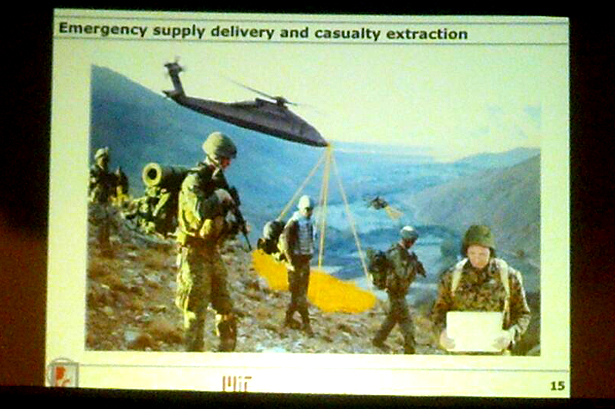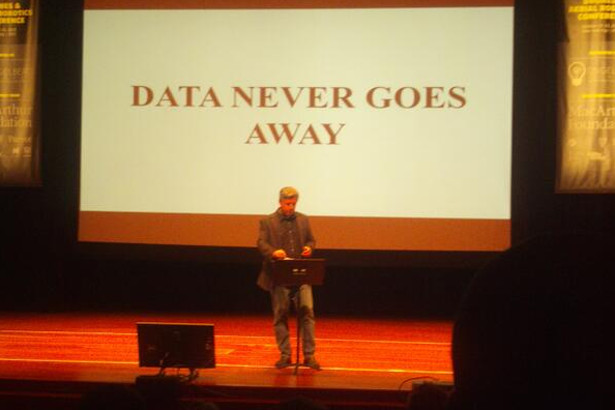
The word “drone” is politically fraught and technically misleading. Fraught because it refers to technology used for a range of practices, including precision agriculture, military strikes, surveillance journalism and personal amuseument; misleading because the understanding that the technology is “unmanned” or “autonomous” is not (or not yet) completely accurate. There’s still a human in the loop, if not in the cockpit. Someone has to set the coordinates, write the algorithms and define the intention. The word obscures human agency and clouds responsibility. Ambivalence toward responsibility and embracing inevitability were recurring themes throughout DARC, the Drones and Aerial Robotics Conference held at New York University on October 11 to 13.
Some working with drones avoid the word “drone” insistently. Michael Toscano prefers the term used by his own industry association, the Association for Unmanned Vehicle Systems International. Others, like former fighter pilot and MIT professor Missy Cummings, insist that “drone” is the nom de guerre whether we like it or not — it’s short, it’s resonant and, thanks to media coverage, it’s already established in the public consciousness.
No matter what term people want to use for the myriad forms of flying robots (“flying robots” is not especially popular), speakers in dozens of keynotes, presentations and roundtable discussions insisted that these things are about to dominate the global landscape, and there’s nothing that anybody can do about it.
Yet the form that domination takes is in part contingent on the motives and actions of what constitutes the aerial robotics community. At DARC, startup types and conceptual artists mingled with former and current military officials, lawyers, journalists and human rights activists. Drone technology is a strange but unsurprising intersection of the maker movement — hackers, tinkerers, hobbyists — and the military-industrial complex.
It’s unsurprising because, as was reiterated many times during the conference, drones are not the first or the only game-changing technology to emerge from the military; the Internet itself emerged out of the collective efforts of academia, DARPA and tinkerers. Though there are obvious differences between the Internet and drone technology, drones are similarly catalytic. Aerial, semi-autonomous data-gathering robots further dismantle the illusion that online space is separate from physical space. People have been carrying portable data collection devices in their pockets for years now. According to industry, in the not-too-distant future such devices will be airborne, and even more ubiquitous.

Of course, that not-too-distant future is already here in some places in the world, and it doesn’t look very pleasant. Attendees of DARC were notably uncomfortable about this, apparently seeing little to no relationship between their work as hackers and entrepreneurs with drone-delivered atrocities in Pakistan and Yemen.
In the United States, the future of domestic drone use is also contingent on the Federal Aviation Administration. People on varying points of the political spectrum maligned the FAA throughout the weekend — from industry-types, insisting it is holding back innovation, to transparency advocates like the Electronic Frontier Foundation, which filed a lawsuit against the FAA for withholding documents concerning the U.S. government’s drone use. Thus far, the FAA has been as unclear and illogical in its policies on what citizens can and can’t do with drones as they have been about disclosing what federal and state agencies are already doing with them.
The FAA Modernization and Reform Act, passed in 2012, gave the FAA a deadline of 2015 to create a plan for safely integrating “unmanned aerial vehicles” into the domestic airspace. The contours of that plan and the likelihood that deadline will be met is contingent on a lot of things, including the ongoing government shutdown (which prevented panelists from NASA and NOAA from speaking at the conference) and the influence of lobbyists, think tanks and trade associations.
A glance at the Association for Unmanned Vehicle Systems International’s board members (executives from defense contractors like Northrop Grumman and L-3 Communications) and staff (Toscano, the president and CEO, has a 30-plus-year background in the Department of Defense) might give some idea of what kind of future with drones they’d like to see. But advocates within the industry are quick to insist that they’re not just interested in military applications. They’re interested in innovation. Which is to say, they’re interested in profit. They’re not, apparently, interested in at whose expense that profit is made, and to raise that question at DARC led to accusations of “drone racism.” (Unpacking the instance of a white man declaring that journalist and filmmaker Madiha Tahir was racist against robots would be an essay unto itself.)

While I do believe more precise language is necessary to be clear about the distinction between environmentalists using aerial infrared photography and nations engaging in undeclared wars, to an extent the question of what to call the technology is a bit of a smokescreen, obscuring what’s actually at stake. When we talk about drones, we’re actually talking about power. Power can be used for control, and power can used to share. Power can be gendered, racist, sexy, emancipatory. Participants in the drone community — hackers, lobbyists, lawyers, wonks, journalists — are all part of shaping how that power is understood and used. Refusing to participate in defining that power and insisting on an apolitical discourse makes space for that power to be abused. And we’re already seeing it abused.
If the inevitable future is to be one that is worth living in, the power dynamics of drone policy and technology will need radical evaluation and reconfiguration. I hope that journalists, hobbyists and activists alike will follow the money, listen to and seek out victims, understand the impact, and understand that acting with intention is not inherently anti-innovation but actually anti-killer robots.
I also hope that activists already engaged with issues around drones recognize they can’t unilaterally reject or avoid drone technology any more than they can reject smartphones or laptops. The current landscape is, literally and figuratively, in the air. If technologists and activists myopically refuse to engage with and shape this technology’s use on a political and social level, they might not like what they see when they finally look up.
